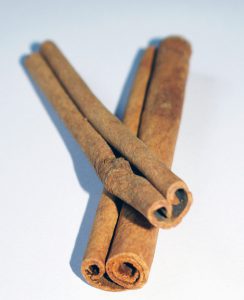
HERBS not only have the capacity to give the food we eat extra aroma and flavour but, as a regular part of our diets, they can offer many health benefits as well. Many herbs have been known about for centuries and used by many different cultures for enhancing food, and also for their health advantages.
And, happily for those of us hoping to manage our blood pressure naturally, there is available a variety of herbs at the supermarket which can have positive benefits.
Today I am going to take a look at 6 herbs which can play a role in helping to lower blood pressure:
1. Basil
2. Cardamom
3. Flaxseed
4. Garlic
5. Ginger
6. Cinnamon
★ ★ ★ ★ ★ ★
Basil
What is it? – This herb is know in culinary circles as “the King of the Herbs” and has been around in India, where it originates, for about 5000 years, although nowadays it is used universally in food preparation. It is also variously known as Great Basil, Holy Basil, Sweet Basil and St John’s Wort!
How does it help with blood pressure? – Using extract of Basil has been shown in one Study from China to lower blood pressure by targeting proteins, called Endothelins which constrict the blood vessels. And more recent research – cited in the Journal of Natural Remedies; January12 edition – using Basil to treat metabolic syndrome, of which Hypertension is often a component, showed promising results by giving test subjects 5 mlls of Holy Basil extract twice a day for 3 months. In this case the systolic – or upper BP readings – dropped by an average of 13 points and the diastolic – or lower readings – fell by an average of 8 points.
Whilst more research into the blood pressure lowering properties of this herb is recommended, these initial findings are very encouraging.
How to use – Add the fresh leaves from a small pot of Basil kept in the house to salads, soups, casseroles and pastas.
★ ★ ★ ★ ★ ★
Cardamom
What is it? – It is a spice produced from the seeds of 2 types of plants found in India and south-east Asia. One genus provides us with green cardomom – or true Cardamom (Elettaria cardamomum) – and the other with black cardomom (Amomum costatum). Cardamom is a related to the Ginger family of plants.
How does it help with blood pressure? – Well, this is where Cardamom comes into its own. You see, these little seeds are packed full of nutritional goodness with anti-oxidants and essential vitamins and minerals, including two minerals which are crucial for balancing blood pressure – Magnesium, and Potassium.
Scientifically – Cardamom has been shown to reduce blood pressure in an Indian Study which involved giving test subjects 3000 mg of cardamom powder two times daily for a period of 3 months. Results from the research showed a significant decrease in both upper and lower BP readings, as well as improved anti-oxidant status.
How to use – Given its rather unique taste which has both a hint of citrus with a slight minty, eucalyptus aftertaste, this spice is well suited in breads, meat and rice-based dishes . It also combines well with cinnamon, and can also be taken as a refreshing tea due to its fragrant characteristics.
★ ★ ★ ★ ★ ★
Flaxseed
What is it? – Flax (also called Common Flax or Linseed) has been used for centuries as the raw ingredient for making textiles (linen), and as a source of wholesome food. Flaxseed itself can be found in two forms: yellow (or golden) and brown, and both forms are rich in the Omega-3 fatty acids.
How does it help with blood pressure? – The Omega-3 fatty acids in flaxseed have been shown to help lower serum cholesterol and thereby decrease the risk of developing cardiovascular disease. Hardening of the arteries can often lead to hypertension because the blood vessels begin to lose their elasticity which in turn causes greater pressure to be exerted against the artery walls, as the heart’s workload increases.
How to use – Flaxseed can be quite flexible since, in its milled or ground form, it may be added to almost any dish. I routinely sprinkle cold-pressed milled flaxseed on top of my porridge at breakfast time, but it is just as at home when included in breads, smoothies and soups, or casseroles.

(Note: Flaxseed, once ground, needs to be kept in the fridge to maintain its freshness and potency)
★ ★ ★ ★ ★ ★
GARLIC
What is it? – Well, who hasn’t heard of garlic! It is probably one of the most widely used herbs around the world for its pungent flavour and strong taste. For the record Garlic (scientific name Allium sativum) is a species in the onion genus, Allium. The most popular part of the plant for culinary usage is the bulbous part, usually divided into separate segments called cloves.
How does it help with blood pressure? – Garlic is a natural anti-coagulant or blood thinner, for starters. Thinned blood will flow more easily around the body and will thus exert less pressure on artery walls. In addition to this, garlic is also an ACE Inhibitor which means it has the ability to block the angiotensen I-converting enzyme (ACE) which causes blood vessels to constrict, thus increasing blood pressure
By blocking this enzyme – which is in fact the exact goal of a group of prescription blood pressure drugs called ACE-Inhibitors – garlic is able to help the vessels stay dilated. Garlic contains both Glutamylcysteine and Adenosine which have ACE inhibiting qualities, and to boot it has a high allicin content which promotes relaxation and dilation of blood vessels.
How to use – Garlic really is another flexible source of seasoning and naturally works well, freshly pressed or as a powder additive, for flavouring all kinds meat dishes, stir fries and pasta dishes. It may even be added, although sparingly due to its potency, to smoothies. But if you are one of those people who find it hard to tolerate in its cooked form, there are good quality supplements out there which work just as well.
★ ★ ★ ★ ★ ★
GINGER
What is it? – Again I don’t believe Ginger needs much of an introduction, since it is another one of the most popularly used seasonings in many culinary cultures – and especially in Indian and Asian cuisine! It is the rhizome, or root, of the plant which is used for both medicinal and culinary uses, and when it is fresh is has a spicy, fragrant taste.
How does it help with blood pressure? – Ginger’s benefits come in two ways. Firstly the compounds in Ginger have been shown to have an effect of the amount of LDL (low density lipo-proteins) Cholesterol in the blood.
This is important as high levels of LDLs proteins can cause sticky plaque to build up along the walls of your arteries and blood vessels. This in turn may lead to blockages which can contribute to high blood pressure by restricting the inner diameter of blood vessels and arteries. Plaque may also reduce the pliability of arteries, which further contributes to high blood pressure.
Also Ginger naturally guards against the formation of clots in blood vessels and arteries which may result in poor blood circulation around the body and increased blood pressure.
How to use – Ginger is very versatile. For example, you can buy fresh ginger root and make ginger tea. Ginger is a common cooking spice in meat and vegetable curry dishes, and many Asian dishes. It also lends itself to a variety of foods, including ginger bread, ginger snap cookies and dried candied ginger. As a beverage, not only does it makes a spicy tea, but is also popular in drinks like kombucha and ginger ale. And it is available in extracts, tinctures, oils and capsules.
★ ★ ★ ★ ★ ★
CINNAMON
What is it? – Cinnamon is a spice obtained from the inner bark of several tree species from the genus Cinnamomum. It has been around for a very long time and was first used in Ancient Egypt where is was prized by the ruling classes and used for both embalming and also for burning aromatically.
 In the Middle Ages, as European traders searched far and wide for exotic and expensive spices, there was considerable competition between the Dutch and Spanish Traders, and the British East India Company, as they vied with each other to find sources of Cinnamon in places like India, China and South-East Asia. Eventually, the British East India Company started to grow it commercially in the South-western Indian state of Kerala on the Malabar Coast.
In the Middle Ages, as European traders searched far and wide for exotic and expensive spices, there was considerable competition between the Dutch and Spanish Traders, and the British East India Company, as they vied with each other to find sources of Cinnamon in places like India, China and South-East Asia. Eventually, the British East India Company started to grow it commercially in the South-western Indian state of Kerala on the Malabar Coast.
How does it help with blood pressure? – Cinnamon is a little unique in that its ability to reduce blood pressure is most evident in people who are dealing with diabetes, a common side effect of which is the increased risk of developing hypertension.
Recently University of Toronto researchers studied clinical trials looking at the effect of cinnamon on blood pressure in groups who were either pre-diabetic or had type-2 diabetes. These trials occurred, and three trials in particular met the criterion for their analysis. Their findings indicated that taking cinnamon for a 12 week period did result in a modest reduction in both systolic and diastolic BP readings. And a further study showed that cinnamon can be of benefit to non-diabetic people too.
How to use – In Western cuisine cinnamon is probably most well known as a central ingredient in cinnamon buns and cinnamon bread, as well as used in many packaged cereals and sprinkled on fruits, such as apples. It is also used in chocolate production and can be added to some soups, holiday drinks such as egg nog, and other sweet dishes and pies. For therapeutic uses, fresh cinnamon sticks (containing the Ceylon cinnamon) are best, since the powdered form sold in grocery stores comes from a different source of cinnamon – the Cassia plant – and it can be toxic to humans if used in excess.
Wrap Up
When it comes to thinking about a natural solution for high blood pressure, herbs do not automatically come to mind. As my review has demonstrated however they can indeed play a role in helping to manage blood pressure*, and the beauty is that they can be incorporated quite easily and naturally into your everyday diet. So I think they definitely merit consideration for inclusion in your treatment regimen, if you prefer a natural approach to hypertension.
*Anyone already on prescription medications should however be aware that some herbs mentioned above, especially those with blood thinning properties, may interfere with the effects of said drugs, so please be sure to seek your physician’s advice before trying out these herbs.
I would love to hear from any of you who have thoughts and feedback on the use of herbs to help treat high blood pressure issues. Please feel free to leave your comments below.
